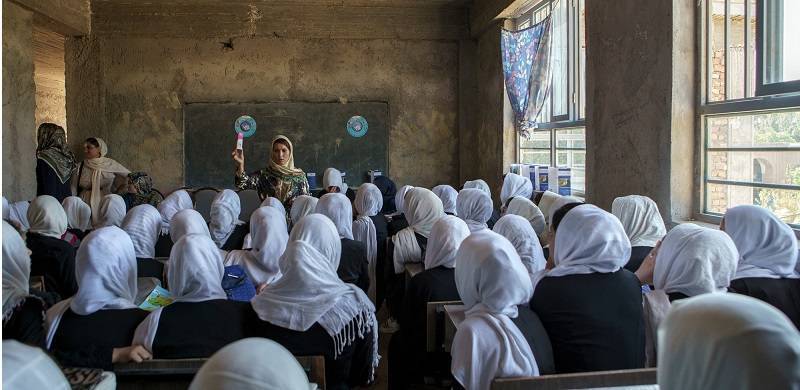
In Punjab, women make up 56% of the teaching workforce in public schools, yet their representation in senior administrative roles remains staggeringly low. Despite this majority, women are largely absent from decision-making positions, such as district education officers and provincial policymakers, where their insights could drive systemic change. In the context of education systems, particularly those grappling with gender disparities, involving women in leadership is not merely equitable but a pragmatic approach to governance. Women, with their lived experiences and proximity to the challenges faced by female students, bring insights that might also overlooked in male-dominated decision-making processes.
This leadership gap not only limits the potential for gender-sensitive reforms but also perpetuates structural barriers that hinder girls’ access to and retention in education. By giving women agency and ownership over decisions that shape the education system, Punjab can address these challenges effectively. Through an examination of research, regional data, and the current provincial context, this article establishes a need for female leadership in administrative roles as a strategy to strengthen the province’s educational framework.
The concept of agency and ownership has long been recognised as a cornerstone of effective governance and systemic progress. In governance structures, empowering individuals to make decisions about issues within their domain of expertise enhances accountability, efficiency, and the alignment of policies with ground realities. A deeper dive into Punjab’s school education data reveals a troubling paradox: while women dominate the teaching profession, their numbers dwindle as one ascends the administrative hierarchy.
According to the School Education Department’s Annual School Census Report of 2023-24, women make up a significant proportion of the teaching staff in Punjab’s schools, yet their representation in senior administrative positions, such as district education officers and school principals, is disproportionately low. The sanctioned versus filled posts by gender further illustrate the systemic inefficiencies: while there are qualified women within the teaching workforce, opportunities for advancement into administrative roles are limited. The implications of this disparity are profound. Women educators, often the most invested stakeholders in girls' education, lack the ownership and decision-making power to influence policies and reforms that directly impact their students.
The lack of female leadership also has a trickle-down effect. Without women in important positions, the system misses out on creating inclusive environments that are critical for girls' retention and success. This is particularly concerning in Punjab, where literacy rates demonstrate a significant gender gap. According to the Pakistan Social and Living Standards Measurement (PSLM) Survey 2019-20, the overall literacy rate for individuals aged 10 years and above in Punjab is approximately 66.3%, with male literacy rates significantly higher than those of females. While exact figures for the 10-14 age group are not readily available, broader trends indicate that female literacy consistently lags behind male literacy, particularly in rural areas.
The Punjab Development Statistics report further highlights that literacy rates for females aged 15-24 are markedly lower than those of males in the same demographic, reflecting persistent educational inequities. Bridging this gap requires leadership that understands and advocates for the nuanced needs of female students, addressing cultural barriers, socioeconomic challenges, and infrastructure deficits that disproportionately impact girls' education.
Women in education are not just teachers; they are potential leaders, reformers, and advocates for the next generation
The high enrollment rates of girls in Punjab’s public schools reflect a significant demand for education among the province’s female population. However, this figure is overshadowed by the stark reality of alarmingly high dropout rates, particularly from the 8th grade onwards. Social pressures, early marriages, financial constraints, and a lack of gender-sensitive infrastructure are among the key factors driving girls out of the education system. The absence of female voices in key decision-making roles means that the unique challenges faced by girls—ranging from school safety to culturally sensitive teaching practices—are often overlooked. The system risks perpetuating solutions that are disconnected from the lived realities of female students. For example, many public schools in rural areas lack separate and functional sanitation facilities for girls, a fundamental need that directly impacts attendance and retention rates.
A study by UNICEF found that inadequate sanitation infrastructure disproportionately affects adolescent girls, particularly during menstruation, forcing many to miss school or drop out entirely. This issue, while widely acknowledged, often fails to receive the urgency it deserves in male-dominated policymaking forums. Another critical concern is the safety of girls traveling to and from school. The lack of safe transport options, combined with cultural taboos about girls traveling unaccompanied, creates significant barriers to secondary education. Culturally sensitive teaching practices are another area where the absence of female leadership is glaring. Curricula and teaching methods often fail to address gender dynamics or incorporate life skills tailored to the unique challenges faced by girls. Furthermore, for many families, the transition from primary to secondary school marks a point where cultural norms and economic limitations converge, forcing difficult decisions that disproportionately impact girls. This trend not only limits the potential of individual students but also undermines broader efforts to achieve gender parity in education.
Studies have found that when individuals are given ownership over decision-making, they are more likely to align their actions with broader organisational goals, nurturing both innovation and motivation. The lack of agency among women educators, despite their significant expertise, prevents them from influencing policies and reforms in ways that could benefit the education system and empower their students. Female leaders bring a nuanced understanding of the challenges faced by girls, enabling the creation of policies that are both inclusive and effective. Their success at the school level, where they consistently improve enrollment and academic outcomes, is supported by global studies such as UNESCO’s Education for All Global Monitoring Report, which highlights how female leaders address barriers faced by female students, and regional evidence from the World Bank showing higher enrollment and retention rates in South Asian schools led by women.
Furthermore, the Annual School Census Report 2023-24 in Punjab demonstrates that schools led by female headteachers achieve higher pass percentages for girls in both science and arts subjects compared to those led by men. This suggests a clear potential for scaling these benefits to the systemic level. Additionally, the presence of women in administrative roles sends a strong message of empowerment, challenging societal norms and inspiring young girls to dream bigger, as noted in reports by organisations like UNICEF and Plan International.
Women in education are not just teachers; they are potential leaders, reformers, and advocates for the next generation. In Punjab, where systemic inefficiencies and cultural barriers have long posed challenges, the leadership of Chief Minister Maryam Nawaz Sharif offers a unique opportunity. As the province's first female chief minister, her administration embodies the philosophy of agency and ownership, signaling a commitment to addressing the barriers faced by women and girls. Her government’s vocal stance on creating an inclusive environment for women and promoting reforms that uplift their roles in society has the potential to lay the groundwork for change. This moment carries immense potential—not just for empowering women within the education system but also for addressing the entrenched challenges of girls’ education. With the right focus and sustained effort, this administration can turn its vision into tangible outcomes, ensuring that education becomes a vehicle for equity and opportunity across Punjab.

